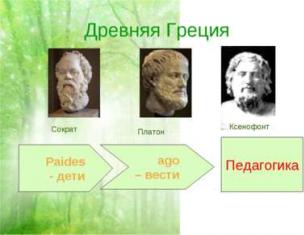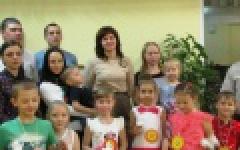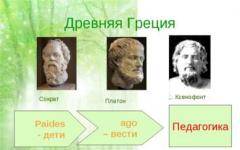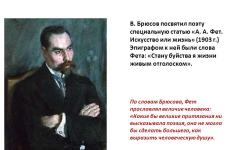Description of the presentation by individual slides:
1 slide
Slide description:
Hiking to places of military glory The work was completed by a 9th grade student from MAOU Secondary School No. 1, r.p. Sacrum Mikhailova Yulia.
2 slide
Slide description:
Report on a one-day trip to places of military glory, made by a group of students of the patriotic club “Memory”, MAOU Secondary School No. 1 r.p. Kresttsy, September 20, 2013 along the route: Kresttsy-Vina-Zaitsevo-Podlitove-Dobrosti-Kushevery-Zakhod-Parfino Trek leader: Vigunova Tatyana Vasilievna
3 slide
Slide description:
Reference information about the route. Hiking area: Krestetsky, Parfinsky districts of the Novgorod region. Date of the hike: September 20, 2013. Route: Kresttsy-Vina-Zaitsevo-Podlitove-Dobrosti-Kushevery-Zakhod-Parfino-Yasnaya Polyana-Kresttsy. Type of tourism: bus and walking. Route length: 97 km Purpose of the hike: to develop patriotism and citizenship among schoolchildren, to educate them and to take pride in the exploits of soldiers during the Great Patriotic War. Objectives: - study the history of the native land during the Great Patriotic War on the Kresttsy-Yasnaya Polyana route. - show the significance of the social activities of the Dolina search expedition, increase interest in the Dolina search movement
4 slide
Slide description:
Technical description of the route “You cannot learn to love the living if you do not know how to preserve the memory of the fallen...” K.K. Rokosovsky. Kresttsy-Vina-Zaitsevo-Podlitove. We left the village of Kresttsy at 8.00 am on a school bus. We follow the federal highway towards St. Petersburg. In Viny we turn to mass graves. The village of Vina was often bombed during the Great Patriotic War, since there was a military airfield here. In the cemetery, which is located one kilometer from the village, 35 soldiers who died during the war are buried in a mass grave.
5 slide
Slide description:
Vina-Podlitove We leave again on the federal highway and continue our journey further. After Zaitsev, in front of the village of Pervomaiskoe, we turn onto Dobrost. About a kilometer from the turn, on a windswept hill, stands a modest obelisk-bas-relief-tribute to the human memory of Stepan Petrovich Komlev. We, who are now living, listen to the voice of the Great Patriotic War, which has reached us through many decades, we bow and lay flowers to our glorious fellow countryman, a native of the village of Podlitove, “whose flock of houses is located just below, in the depression.” This village gave Russia a son devoted and loving to his homeland. He is a participant in the Soviet-Finnish war. In 1940, during an assault on a heavily fortified area on the Karelian Isthmus, his tank company suppressed several pillboxes and ensured a breakthrough of the enemy’s defenses. At the beginning of April 1940, Stepan Petrovich Komlev was awarded the title of Hero of the Soviet Union. During the Great Patriotic War he commanded a tank battalion. At the beginning of 1944, he died liberating the Lithuanian city of Kretinga. He was buried 7 kilometers southeast of the city of Kretinga.
6 slide
Slide description:
7 slide
Slide description:
Podlitovye-Kushevery From Podlitovye we take a bus to the turn to the village of Kushevery, then walk to the village cemetery. On August 31, 1941, near the village of Dubrovy, the 180th Infantry Division of the Northwestern Front under the command of Ivan Ilyich Missan stopped the advance of the Nazi troops. About 600 soldiers who died of wounds in hospitals located in these villages during the war are buried in cemeteries near the villages of Dobrosti and Kushevery. We lay flowers at the graves of soldiers in the cemetery in the village of Kushevery. We honor their memory with a minute of silence.
8 slide
Slide description:
Slide 9
Slide description:
Kushevery-tract Sunset. From the village of Kushevery we walk 2 km along the road to the village of Parfino, get on the bus and go towards the Pavlovo farm. There are 2 farms on the Pavlovo farm - Medvedeva O.V. and Romanova A.M. (engaged in crop production and livestock farming). From the Pavlovo farm we go along a very dirty tractor road to the former village of Zahod / tract Zahod / 3 kilometers. We are accompanied by a resident of the farm, Romanova Zoya Mikhailovna, who annually on May 9 visits the mass grave and lays flowers at the obelisk. On the way, we notice that the ground around is dug with trenches that have been preserved since the war. In the forest area, in the Zakhod-voinskoe tract, the military cemetery is a mass grave of soldiers who died from wounds in hospitals that were located in the villages of Dobrosti and Kushevery during the Great Patriotic War. The mass grave near the former village of Zahod was located on the territory of the Verkassky village council (liquidated in 1963). Sometime in the 70s, female state farm workers gave them a decent appearance for the last time by cutting down the bushes and digging in the ridges. Since then, no one has come to bow to the memory of the soldiers lying here. In 2003, a forester accidentally stumbled upon a mass grave. The Krestetsky search team "Honor", under the leadership of Sergei Aleksandrovich Kovalenko, in June 2003 carried out a lot of work to improve the burial area. On June 20, 2003, a funeral ceremony took place here. Our group, having arrived at the burial site in the Zakhod tract of the Krestetsky district, cleaned up the place near the obelisk, we laid flowers, and observed a minute of silence in memory of the soldiers buried here.
10 slide
Slide description:
11 slide
Slide description:
12 slide
Slide description:
Zahod tract - Parfino village We return from the Zahod tract to the bus left at the Pavlovo farm. We arrange a small break. Then our path lies in the village of Parfino. We take the Kresttsy-Parfino highway, drive 1.5 km and cross the border of the Parfinsky district. Next, our journey continues through the Parfinsky region. In 1988, the youth of the Parfinsky district decided to perpetuate the memory of those who fought and died near the “Ramushevsky corridor”. A search team called “Dolg” was created. With his participation, a damaged KV-1S heavy tank was pulled out of the swamp. The car was installed at the entrance to the village of Parfino. We stopped at the monument, laid flowers, and took pictures.
Slide 13
Slide description:
Parfino village - Yasnaya Polyana Next, our path lies to Yasnaya Polyana. And here it is - the main Parthian memorial under the textbook name Yasnaya Polyana. The remains of thousands and thousands of Red Army soldiers found by search engines in the Parfinan forests and swamps are reburied here. Our squad includes three members of the “Valley” search expedition. They represent the Krestetsky search squad "Eskander". These are Andrey Vanyakhin (worked in the detachment for two seasons), Alexander Kolyasnikov, Alexey Senkin (one season each). According to Andrei Vanyakhin, the trip to Parfino became one of the most important events in his life. He told the guys that the most significant find of the 2013 spring watch was a death medallion, which contained information about a soldier of the 370th Infantry Division, Stepan Semyonovich Molochnyuk, born in 1903, who died on October 29, 1942. The remains of the fighter were recovered on May 4, 2013. Now there is painstaking work to be done not only in finding the relatives of the soldier himself, but also in finding possible information about the four dead whose remains were found in the same dugout as him. And on May 8, 2013, at the memorial in the village of Yasnaya Polyana, Parfinsky district, a traditional ceremony for burying the remains of the victims took place. Commanders of search teams from various parts of the country were awarded Certificates of Honor. Among them are A. Kotov (search team “Eskander”), S. Kovalenko (Krestetsky search team “Chest”). The search guys said that during the spring Memory Watch, the camp of our Eskander detachment was set up in the Strelitsa tract in the Parfinsky district. In 1942, there was a fortified area here, and there was fierce resistance to German troops. The task of the Red Army soldiers was to capture the pillboxes built by the Germans. According to official data, in three months in this place 650 of our soldiers were killed in the ground, but no one can say with accuracy how many in reality today. According to their stories, the local land is simply strewn with human remains, soldiers’ household items, shells - everything that is associated with the terrible and bitter word “war”. “Eskanderites” also talked about an officer’s tablet found during this expedition, a personalized bowler hat, on which the inscription “Gorky region, Pervomaisky district, village” was scratched by a soldier’s hand. Fedotovo, Panin”, about other finds. Extraordinary solemnity, a feeling of piercing sadness, pride in the greatness of the massive feat of the Russian people - we experienced all these feelings while in Yasnaya Polyana. It is here that a clear realization comes of how important and necessary search work is, how sacred the memory of a simple Russian soldier who protected the world from fascism is. A minute of silence. ...To this day he clutches a machine gun in his hand, On a bed of blood, cartridges, grenades, They look out of the darkness with reproachful eyes: “Have you forgotten us, people?!” I am a Russian soldier!..."
Project objectives
- Find out what events took place in our region during the Great Patriotic War.
- What monuments dedicated to the war are there in our region?
- Which relatives took part in the war?
- City - Hero - the highest degree of distinction awarded cities for the mass heroism and courage of its defenders shown in the Great Patriotic War of 1941-1945.
- By order of the Supreme Commander-in-Chief of May 1, 1945, the first hero cities were named Leningrad, Stalingrad, Sevastopol and Odessa . Today the title of hero city also belongs to: Kyiv, Moscow, Kerch, Novorossiysk, Minsk, Tula, Murmansk, Smolensk, Brest Fortress (hero-fortress).
- “It seems to me: when the fireworks thunder, the dead blockade survivors stand up.
- They walk through the streets towards the Neva, like all the living. They just don't sing.
- Not because they don’t want to be with us, But because the dead are silent.
- We don't hear them, we don't see them, But the dead are always among the living.
- They walk and look, as if they are waiting for an answer: Are you worth this life or not?..”
- Leningraders were given bread on ration cards. the rate of distribution of bread to the population in the period from November 20 to December 25, 1941 was the lowest and amounted to: for workers - 250 grams of surrogate bread per day, for employees, dependents and children - 125 grams per person. There is a Piskarevskoye cemetery in Leningrad, where 650 thousand ordinary people who died of hunger are buried.
- The only road along which food was transported to besieged Leningrad ran across the frozen Lake Ladoga - "The road of life".
- When the Great Patriotic War began, my great-grandfather was an officer in the Soviet Army.
- Already on the very first day, in the very first hours of the war, he had to defend the border of our Motherland.
- He was fearless in battles with the enemy, was seriously wounded three times, was hospitalized, but returned to duty again!!!
- During the war years, he had to fight on several fronts: on the Ukrainian front, on the Belorussian and on the Leningrad front.
- At the walls of my native Leningrad,
- Where the sea splashes like a wave,
- Your fascist ambush,
- All consisting of reptiles
- The enemy surrounded it with a wall.
- He wanted to blockade the city,
- But the people paved the way for Rokadu...
- Across Ladoga, cars row after row -
- Like at a gala parade.
- Leningrad was saved!
- Rokada is a road running parallel to the front line.
- People!
- While hearts are knocking
- Remember
- At what price is happiness won?
- Please,
- Remember!
To view the presentation with pictures, design and slides, download its file and open it in PowerPoint on your computer.
Text content of presentation slides: Virtual tour of the places of military glory of Volgograd (in people's memory) History teacher of the Municipal Educational Institution Gymnasium of Krasnoslobodsk Sushko G.A. Who doesn’t know Stalingrad? Where the bastard German was defeated? Who doesn’t know that fortress that changed the war? Where the Nazis were defeated, Where millions died. Terribly pitiful groans were heard for miles. Where green greatcoats flashed among the black walls, Where shelling was heard, Chimes and the roar of steel. Where people stood up for the Fatherland like a strong wall. No? Don’t you know this? Well, then see for yourself. On the Mamayev Kurgan, Rising above the clouds, In memory of Stalingrad, there stands a mighty monument. You will honor the memory of your ancestors, Those who were killed, Those who fought and suffocated from the fumes. Climb the mound, Bow to the fallen there .In memory of the Battle of Stalingrad
Soldier's Field North-west of Volgograd (Stalingrad) there is a field where fierce battles took place during the Battle of Stalingrad. In August 1942, a small defensive line built by the workers of Stalingrad passed through it. On August 23, a small detachment of Soviet soldiers took up defense here and were entrusted with the task of stopping the enemy at any cost. From this day to September 10, 1942, fighting took place; the Nazis tried to destroy the detachment, but the courage of the fighters overturned their plans. Not far from the beginning of the Soldier's Field, a memorial complex was built in memory of the heroic warriors - defenders of the "Soldier's Field" next to the Volgograd-Moscow road. The authors of the complex are sculptors L. Levin, A. Krivolapov. Next to the modest obelisk stands a dead tree, as if scorched by the fire of war. An urn with the ashes of dead soldiers, whose remains were found during demining and plowing of the “Soldier’s Field,” is buried in the mass grave. One of the elements of the Soldier’s Field is the sculpture of a thin girl with a flower in her hand, rushing to the mass grave, as the personification of the saved generation. Next to the girl is a triangle of a letter from Major Dmitry Petrakov with the original text on it.
Pavlov's House Immediately opposite the mill there is an inconspicuous house of pre-war Stalingrad, which was destined to become one of the symbols of perseverance, heroism, and military feat - Pavlov's house. Before the war, it was a 4-story residential building for workers of the regional consumer union. In mid-September 1942, during the battles on January 9 Square, Pavlov’s house became one of two four-story buildings that it was decided to turn into strongholds. On September 22, 1942, the company of Sergeant Yakov Pavlov approached the house and established a foothold in it - at that time only four people remained alive. But, nevertheless, for the artillerymen the house was named after the person who first settled in it. So the house became Pavlov's house.
Gergart's MillOn the street. On the Soviet side stands a mutilated 5-story red brick building, scorched by fire, with a collapsed roof, soot, and countless traces of bullets and shells. These are the ruins of the Grudinin mill, which were left as of 1943 as a monument to war-torn Stalingrad and the heroism of its defenders.
Museum-panorama "Battle of Stalingrad" Museum-panorama "Battle of Stalingrad" is located on the historical site of the landing of the 13th Guards Rifle Division of General A.I. Rumyantsev, which crossed the Volga in September 1942 under enemy fire. For the courage and heroism shown in the Battle of Stalingrad, this division, like many others that defended the city, received the title of Guards. In honor of this, on March 29, 1965, this place received the name Gvardeiskaya Square.
Eternal Flame From the Volga embankment to the Square of Fallen Soldiers there is a small street - Alley of Heroes. In 1985, a memorial monument was opened here dedicated to the Heroes of the Soviet Union and full holders of the Order of Glory who went to the front from the Volgograd region and the heroes of the Battle of Stalingrad. On February 1, 1963, on the eve of the 20th anniversary of the defeat of Nazi troops at Stalingrad, the Eternal Flame flared up at the mass grave. Monument “Extinguisher” From the Volga embankment to the Square of Fallen Soldiers there is a small street - Alley of Heroes. In 1985, a memorial monument was opened here dedicated to the Heroes of the Soviet Union and full holders of the Order of Glory who went to the front from the Volgograd region and the heroes of the Battle of Stalingrad. On February 1, 1963, on the eve of the 20th anniversary of the defeat of Nazi troops at Stalingrad, the Eternal Flame flared up at the mass grave.
The streets of Volgograd are named after them. The 62nd Army embankment is the central embankment of Volgograd. 64th Army Street, 33rd Heroes Street, 51st Gvardeyskaya Street, 7th Gvardeyskaya Street, 13th Gvardeyskaya Street, Chekist Street,
The streets of Volgograd are named after them. Alexander Ilyich Rodimtsev - Soviet military leader, Colonel General (May 9, 1961). Twice Hero of the Soviet Union (1937, 1945). Commander of the 13th Guards Rifle Division, which particularly distinguished itself in the Battle of Stalingrad (01/19/1942 - 05/21/1943). Thanks to the courage of the guardsmen of General A.I. Rodimtsev, the enemy did not break through to Gvardeiskaya Square. In memory of the merciless battle, the ruins of the legendary mill No. 3 were left on the square for centuries. The streets of Volgograd were named after them. Shumilov Mikhail Stepanovich - Soviet military leader, colonel general. Commander of the 64th Army, which particularly distinguished itself in the Battle of Stalingrad. Hero of the Soviet Union (1943). The village in the Kirovsky district is crossed from north to south by a wide asphalt street with new multi-storey buildings. It bears the name of the 64th Army. This legendary army, commanded by General M.S. Shumilov, traversed a glorious path. Its formations and units stood to the death near the Volga, protecting the approaches to the southern part of the city. A difficult defensive battle near the walls of the Volga stronghold ended in victory for the Soviet troops and the capture of the commander of the 6th German Army, von Paulus. The streets of Volgograd are named after them. Vasily Andreevich Glazkov - Soviet military leader, Major General (1942). General Glazkov commanded a division that fought defensive battles in the area of the village of Verkhnyaya Elshanka. In the midst of a fierce battle, he was seriously wounded, but continued to lead the battle. On the way to the division command post, the general was wounded again. The third wound turned out to be fatal. In 1957, the remains of V.A. Glazkov from across the Volga, where he was buried during the days of the fighting, were transferred to the Komsomolsky Garden, near the drama theater, and a monument-bas-relief of the division commander was erected on the grave; his overcoat, riddled with bullets and shell fragments, is exhibited in the Museum of Defense (now it is located in the Panorama Museum “Battle of Stalingrad”). There are several streets of Glazkov. The streets of Volgograd are named after them. Sergei Stepanovich Markin is a Soviet officer, participant in the Great Patriotic War, military pilot, Hero of the Soviet Union. Sergei Markin Street in the Kirovsky district is named after a participant in the Battle of Stalingrad, a man of great courage. The streets of Volgograd are named after them. Vladimir Petrovich Khazov is a Soviet officer, tank ace, participant in the Great Patriotic War, Hero of the Soviet Union, senior lieutenant. Hero of the Soviet Union V.P. Khazov has 27 enemy tanks on his personal combat account; The tank company commander died, but kept his word to his mother: “We won’t let the Nazis cross the Volga!” » In Razgulyaevka there is Tankist Khazov Street. Mikhail Averyanovich PanikakhaMikhail Averyanovich Panikakha - deputy squad commander of the 1st company of the 883rd Infantry Regiment of the 193rd Infantry Division of the 62nd Army, Hero of the Soviet Union. On October 2, 1942, in a battle defending the Red October plant, Red Army soldier Mikhail Panikakha performed a heroic feat. Enemy tanks were moving towards the trench in which he was located. Taking two bottles with flammable liquid, Mikhail crawled towards the lead German tank. The bullet hit one of the bottles, the liquid instantly spread over the soldier’s body and ignited. Flashing a torch, Mikhail rushed to the grille of the engine hatch and broke the second bottle against it. The German tank stopped. For this feat, on December 9, 1942, Mikhail Panikakha was posthumously awarded the Order of the Patriotic War, 1st degree. Mikhail was buried in a deep crater, near the Red October plant. Tank towers Mamayev Kurgan - Motherland Mother Mamayev Kurgan is the main height for which the battle took place in the Battle of Stalingrad. Here the entire earth was mangled by shells and dead soldiers. To perpetuate the feat of the soldiers killed in this battle, the Mamayev Kurgan memorial was opened in Volgograd in 1967. Its central sculpture is the Motherland Calls monument. In the center of the Hall of Military Glory there is a monument - a torch with an eternal flame.
Second of February - Victory in the Battle of Stalingrad! Mound, sculpture of the Mother Fatherland, silence... And as in a silent... and black and white, old film, the sad step of the Descendants... Heart... and Soul... The step is not minted here. Everything is open here... Veterans, Grandfathers and Fathers are walking... And they bow to the names of the killed For the life that followed... Mothers... Sons... Medals are ringing... Scarlet carnations - On the marble of Memory from all the Living! And Russian, eternal Forgive... On the slope... in the Temple of All Saints... A minute lasts... Believe in Tears... And Life, like Repentance, is long! And your Feat... of course cannot be measured... All because... the Motherland... One! - Sergey ShcheglovThank you for the victory!
Svetlana Smykova
Slide presentation: “Places of military glory”
Slide 1. By places of military glory.
Slide 2.
Square glory- a small and cozy park in the center of Michurinsk. The square received its name on May 9, 1995, at which time an architectural ensemble was installed here "Defenders of the Fatherland", rising in the center of the Square Glory in the Park.
Slide 3
The names of the residents of our city, the heroes of the Soviet Union who died in this war, are carved on the slabs.
Slide 4
On Victory Day Square Glory becomes a place holding ceremonial rallies.
On the eve of Victory Day, I would like to touch upon the topic of those killed during the war in our city.
Slide 5
In a cozy park on Sovetskaya Street there is a bust of the hero of the USSR Nikolai Antonovich Filippov. Participant in the Battle of Stalingrad and the Berlin Operation. This young sailor, a native of the city, died at the end of the war, during the Berlin operation, commanding a boat of the military flotilla. The street on which he was born was renamed in honor of the sailor, and the bust itself was made by sculptor Y. Titov and installed in 1987.
Slide 6
There is also a military burial, which is located in the Main Nursery. Test pilot Pavel Dmitrievich Yurkevich was sent in August 1942 to cover the railway junctions and defensive points of Tambov and Michurinsk. On August 6, during a mission, the MIG-3 aircraft piloted by Sergeant Yurkevich lost control. As a result, the young pilot died.
Slide 7
Memory should be not only in words but also in deeds. On September 14, 2016, a historical event took place in the center of Michurinsk. In the park at the intersection of Internatsionalnaya and Ukrainskaya streets, a bust of the hero of the Soviet Union Alexander Iosifovich Rorat was unveiled, after whom the built park was named. Senior Sergeant Alexander Rorat was a gunner in an artillery regiment. He died heroically in 1943 on the battlefield.
Slide 8
Not far from the Kochetovka microdistrict there is one mass grave in which 28 residents of the village found their final refuge "Five Year Plan" and educational farm "Komsomolets". They disappeared during another bombing in 1942.
Slide 9
Many residents of Kochetovka have seen and know the military burial of young anti-aircraft gunners. Two girls - Maria Rodionova and Tatyana Novotochina died on the night of June 8-9, 1943 during the bombing of the Kochetovka station, repelling an enemy attack. An anti-aircraft gun was installed next to their memorial, and a couple of years ago an alley was planted.
For residents of Kochetovka this place not just a symbol of memory, but proof of the feat of Soviet soldiers.
Publications on the topic:
Almost a month has passed since the Nativity of Christ. In a publication dated January 6, which was called “The earliest on Christmas Eve.”
Lesson summary “Travel to the holy places of the Kursk region” Topic: “Travel to the holy places of the Kursk region” Thematic field: holy places of the Kursk region (cathedrals, temples, monasteries). View.
 Toy Library Holiday - presentation of the family “Minute of Glory”. Goal: to form in children an idea of the family as people who love and care.
Toy Library Holiday - presentation of the family “Minute of Glory”. Goal: to form in children an idea of the family as people who love and care.
Research project for children 6–7 YEARS OLD Topic: “Hiking trails in their native places.” RESEARCH PROJECT FOR CHILDREN 6-7 YEARS OLD Topic: “HIKING TRAILS IN THEIR NATIVE PLACES.” PROBLEM: Accumulation of knowledge and practical skills.
Summary of organized educational activities in the senior group “We remember the feat of combat” (cognitive development) Compiled by: teacher of GBDOU kindergarten No. 28 of a general developmental type with priority implementation of cognitive-speech activities.
Put the pieces in their places! Goals. Continue to introduce flat geometric shapes - square, circle, triangle, oval, rectangle;.
When drawing up the annual plan for the event, we set a task for the new school year: raising the patriotic consciousness of senior preschool children.








